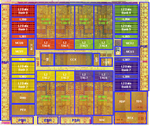The importance of open source in hardware


Personally I think its UltraSparc open source processor, dubbed Niagara, may be more important in the long run. (That's the lay-out of the new chip, from Sun.)
ZDNet Asia reports this week that Sun is happy with the progress of the Niagara program and will release the source code for a second generation processor.
As Moore's Second Law (chips become more complex and become more expensive) continues to bite, chips are increasingly going to be produced by "fab-less fabs," design houses which don't own production facilities.
Production will have to be co-oped. Organizing and coordinating the design process so the right gear can be had by the co-op is crucial. Open source can help that process.
It is still possible for a fab-less fab to have success from a proprietary base. But Moore's Second Law will continue to bite, and the cost-savings from sharing some development resources will become increasingly important.
Having a solid base on which to build will also help new innovations come to market, since those makers will only have to concentrate on what's new. It will also enable new competitors to exist, since they won't have to hold all the IP of their new designs.
The open source hardware movement, in other words, has barely begun.